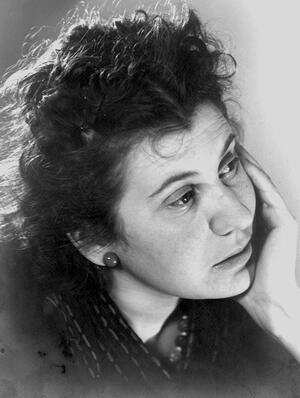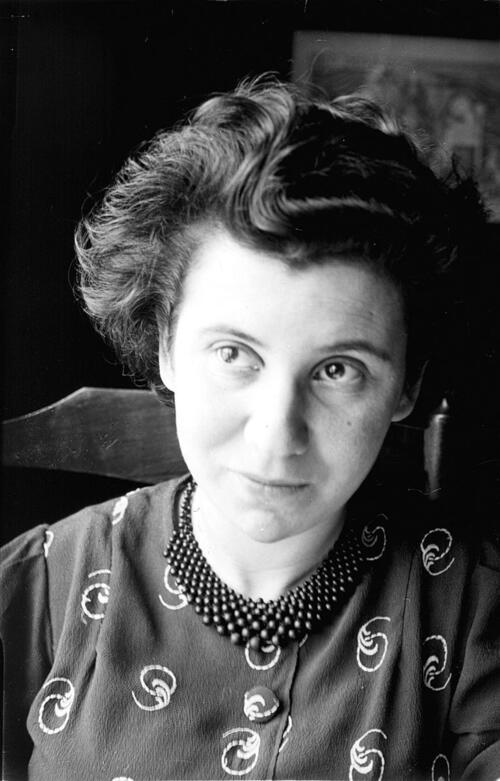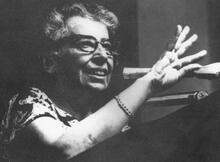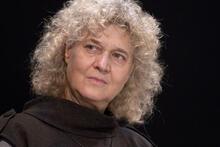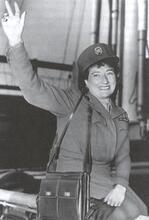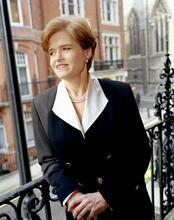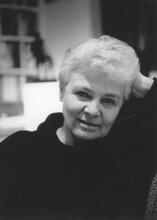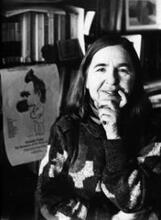Etty Hillesum
Etty Hillesum’s diary, which she kept between 1941 and 1943, is the only extant source about her. Hillesum’s diary reflects a mature, nonconformist Dutch woman attempting to grapple with the changing landscape of her internal world. In doing so she develops a mystical relationship with the God inside of her. When Hillesum is forced to wear the Yellow Star in April 1942, she realizes she cannot ignore the political realities of her external world any longer. Her diary is explicit in its expression of sexuality; Hillesum simultaneously took Han Wegerif and the “psychochirologist” Julius Spier as her lovers. After Spier’s sudden death in September 1942, her diary reads like a long prayer to her personal God. Hillesum was murdered at Auschwitz in December 1943.
“The thinking heart of the barracks,” as Etty (Esther) Hillesum signed an entry in her diary, was born on January 15, 1914, in Middelburg, the Netherlands. Written between 1941 and 1943, this diary is the only extant source for knowing her thoughts and personality. Thus the extent of her biography covers a period of only two years in an already short life. The bare facts of the first period of that life were collected by the editor of her diary, J. G. Gaarlandt.
Early Life & Family
Hillesum grew up in Deventer, a small city in the east of the Netherlands. There she attended the local gymnasium, of which her father, Dr. L. Hillesum, was the director and where he also taught classical languages. Her mother, Rebecca Bernstein, was born in Russia but fled to the Netherlands because of a pogrom. Hillesum and her two brothers, Mischa and Jaap, were unusually gifted. Mischa was a pianist who performed Beethoven in public at the age of six and held the promise of being one of the greatest piano players in Europe. Jaap finished the Gymnasium [high school] in less than the normal six years and became a physician after discovering some new vitamins when he was seventeen. When Hillesum was eighteen she moved to Amsterdam, where she initially took her first degree in law and then enrolled in the faculty of Slavonic Languages to study Russian. All three were promising young people whose lives were cut short simply because they were Jews.
Just before the war Hillesum became a housekeeper in a huge house (Gabriel Metsustraat 6) overlooking the Museumplein, with the Concert Hall at one end and the Rijksmuseum at the other. The owner of the house, 62-year-old Han Wegerif, soon became her lover. The “family” inhabiting “father” Han’s house were, together with students whom she taught Russian, the first main circle of characters described throughout the diary. The second circle were people associated with Julius Spier (“S”), a 56-year old “psychochirologist” who diagnosed by reading palms and, following analysis training with Carl Jung, also provided therapy—albeit of an unusual kind. After a few therapeutic sessions Hillesum became his assistant, intellectual partner and ultimately also his lover.
Part One: Hillesum’s Internal World
Hillesum started her diary on March 9, 1941, when the Germans had occupied the Netherlands for nearly a year. Yet it was not the war that seems to have prompted her writing. Overwhelmed by Spier’s charismatic personality and teaching, she used her diary to think and to comprehend the essence of human nature while simultaneously rebuilding her personality. As her diary progressed, she developed religious insights that had little to do with established religion and culminated in a mystical relationship with the God inside her.
The diary consists essentially of three parts, closely reflecting the main development of her personality. The first part, from March 9, 1941, to April 29, 1942, describes Hillesum’s internal changes after she met Julius Spier. The war, the occupation of the Netherlands, and the Germans are rarely mentioned and she seems to omit these themes intentionally. This is stated quite explicitly: “Only a few months ago I still believed that politics did not touch me and wondered if that was ‘unworldliness,’ a lack of real understanding. Now I don’t ask such questions any more” (143). Whenever the Germans are mentioned, it is either with moderate hatred towards them, or to pity them. For example, “If there were only one decent German, then he should be cherished despite that whole barbaric gang, and because of that one decent German it is wrong to pour hatred over an entire people” (25). And, after being yelled at and threatened by a Gestapo agent: “I am not easily frightened. Not because I am brave but because I know that I am dealing with human beings and that I must try as hard as I can to understand everything that anyone ever does. And that was the real import of this morning: not that a disgruntled young Gestapo officer yelled at me, but that I felt no indignation, rather a real compassion, and would have liked to ask: ‘Did you have a very unhappy childhood, has your girlfriend let you down?’” (102).
Her need for writing in the diary was motivated by the needs of her internal world, not of that outside. For example, after not having written for two months: “I must work on myself some more, there is nothing else for it. A few months ago I did not need all this effort, life was so clear and bright inside me and so intense: good contact with the outer and inner worlds, life-enriching, broadening of the personality; student contacts in Leiden: Will, Aime, Jan; my studies; the Bible; Jung and then S., and always S. again” (40).
Part Two: The Reality of the Yellow Star
But the reality of the outside world forced Hillesum to stop ignoring it. That outside world penetrated rudely into her sheltered life on April 29, 1942. Up to that day, Hillesum could move freely and anonymously in Amsterdam, use public transport or her bicycle, and live outside the “ghetto” in one of Amsterdam’s most affluent and beautiful sections, certain of good meals, real coffee and hot chocolate, and able to spend her nights in the embrace of her lover. On April 29 she lost her anonymity. That was the day that the Dutch Jews were ordered to wear the Star of David.
The entry for that day shows that the very fact of wearing the Star changed her and the essence of her identity, as she explicitly states. “For something inside me has suddenly changed and I know now that I shall follow S. wherever he goes and share his sorrows” (144). And, for the first time, pride in being a Jew: “I am so glad that he is a Jew and I a Jewess” (144). Although she struggles to maintain her inner world tranquil and harmonious, not to lose faith in humanity, in herself and in her ever-increasing religiosity, there is a change in her diary. After April 29 she shows that she is everything but “unworldly” and that her understanding of reality and of her own future was greater than that of many a contemporary.
In fact, her apprehensions of the reality are so accurate that they sound almost prophetic. She starts reporting the antisemitic laws that follow one after the other. At the beginning of June 1942, “Jews may no longer visit greengrocers’ shops, they will soon have to hand in their bicycles, they may no longer travel by tram and they must be off the streets by eight o’clock at night” (157). “The latest news is that all Jews will be transported out of the Netherlands through Drenthe Province and then on to Poland. And the English radio has reported that seven hundred thousand Jews perished last year alone, in Germany and the occupied territories. And even if we stay alive we shall carry the wounds with us throughout our lives. And yet I don’t think that life is meaningless. And God is not accountable to us for the senseless harm we cause one another” (168–169). On July 1, 1942, she records this gruesome foresight: “I am in Poland every day, on the battlefields, if that’s what one can call them. I often see visions of poisonous green smoke; I am with the hungry, with the ill-treated and the dying, every day, but I am also with the jasmine and with that piece of sky beyond my window; there is room for everything in a single life” (170). And on July 11, 1942: “The Jews here are telling each other lovely stories: they say that the Germans are burying us alive or exterminating us with gas. But what is the point of repeating such things even if they should be true?” (192).
The Diary’s Explicit Sexuality
Although Hillesum is quite clear about having a sexual relationship with Han, April 29 is also when she states about Spier: “And yesterday I lay on that bed, for the first time naked in his arms, and it was less a night of love than that time. And yet it was good. It was not exciting, there was no ecstasy. But it was so sweet and so safe” (151). The section that appears only two pages earlier could have followed here. “And Han? Isn’t that a natural process as well? I shall slip away from him very gradually until suddenly I shall be gone altogether, and I know that my heart will break many times when I think of him, about him, and also about me” (149). Indeed, this nonconformist woman, a feminist of intellectual independence and with wisdom far beyond her years, maintained a sexual relationship with both men at the same time. In her words: “I have broken my body like bread and shared it out among men. And why not, they were hungry and had gone without for so long” (251). These sections may explain why the diary was published only in 1981, whereas the Diary of Anne Frank, written by a child who was so much more naïve and innocent, had already become a world best-seller three decades earlier. Obviously the innocence of a child was a more acceptable symbol of the murder of six million innocent Jews than this mature and wise woman whom many have come to love solely by reading her words.
Part Three: A Long Prayer to God
The last quotation was from the end of the diary, in fact from the last page, and uses a religious metaphor that has significance both in Judaism and Christianity. This characterizes much of the third section of the diary. On July 15, 1942, Hillesum took a job with the Judenrat and worked there for two weeks. She terminated this job, which she despised, by volunteering to accompany the first group of Jews that was sent to the Westerbork Durchgangslager (transit camp). This apparently bought her some privileges, for example the right to return to Amsterdam several times. The third and last section of the diary, which starts on September 15, 1942, during her first trip back to Amsterdam after Spier had suddenly died of illness, is both in style and spirit quite different from the first two sections. It reads like a long prayer to her personal God, interspersed with the aftermath of her feelings about her lover’s death and her attempts to cope with her emotions. It ends on October 8, shortly before her return to Westerbork. No doubt aided by her religious faith and in spite of failing health, Hillesum survived Westerbork until September 7, 1943, when she, her parents, and her brother Mischa were put on a transport to Auschwitz. Her faith did not help her to survive there; she died in Auschwitz barely three months later.
Brenner, Rachel Feldhay. Writing as Resistance: Four Women Confronting the Holocaust: Edith Stein, Simone Weil, Anne Frank and Etty Hillesum. Pennsylvania: Pennsylvania State University Press, 1997
Hillesum, Etty. A Diary: 1941–1943. London: N.p., 1986.

